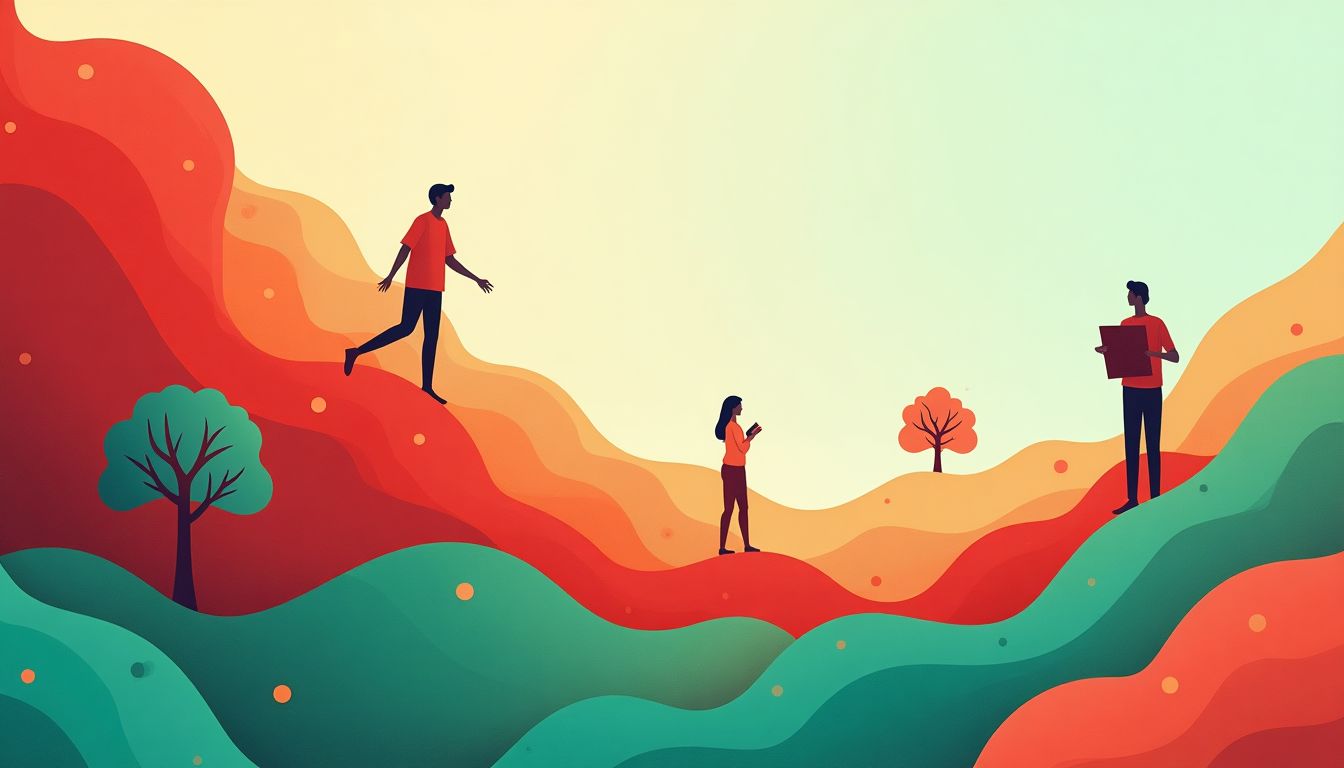Introduction: The Shift in Our Lives
Busy is a choice. Stress is a choice. Joy is a choice. Choose wisely. – Unknown. In today’s world, where the lines between work and personal life often blur, this saying resonates deeply. With the rise of hustle culture and the glorification of being constantly busy, many have positioned themselves in a race where the finish line is never reached. As we navigate an increasingly automated landscape, one surrounded by apps, notifications, and the overwhelming pressure to achieve more, the question stands: are we truly living, or merely existing in a cycle of never-ending work? The irony stares us in the face; as we strive for efficiency, we risk becoming addicted to busyness itself. This article unravels the complexities of work addiction in our rapidly evolving society, where the allure of productivity grips a generation that struggles to embrace the quieter, more reflective moments of life.
In her book Rest: Why You Get More Done When You Work Less, Alex Soojung-Kim Pang argues that taking breaks is essential to creativity and productivity. Meanwhile, researchers like David Rosenfield and Hernan Murdock have highlighted the correlation between work addiction and mental health disorders. As we analyze the ongoing battle between productivity and well-being, can we reshape our perceptions of work and learn to cherish balance over busyness? In this post-work world, the stakes couldn't be higher.
1. Understanding Work Addiction: A Cultural Phenomenon
Work addiction, often defined as a compulsive need to work incessantly, has become a pervasive issue in modern society.
1.1 The Definition and Symptoms
What does it really mean to be addicted to work? Work addiction goes beyond simply being a hard worker; it’s about the compulsive need to keep working, even when it’s detrimental to personal well-being. Psychologists have identified several symptoms associated with this behavior, including:
- Inability to detach from work responsibilities.
- Feeling guilty when taking breaks.
- Neglecting personal relationships for work-related tasks.
- Experiencing anxiety and insomnia due to workload.
Statistics indicate that around 10% of people identify as workaholics, a number that may be on the rise as our world becomes increasingly digital. The smartphone, while a powerful tool for productivity, has transformed into a double-edged sword, perpetuating an “always-on” mentality that contributes to work addiction.
1.2 Societal Expectations and Norms
How did we get here? Societal norms and cultural influences play significant roles in fueling work addiction. In many cultures, success is often measured by the hours clocked at the office or how busy one appears. Media portrayals glorify individuals who sacrifice sleep or leisure time for work, while glorifying busyness as a badge of honor. The question remains: are we falling into the trap of defining our self-worth based on our ability to appear busy, rather than valuing personal fulfillment? This societal expectation creates a cycle of hustle that is difficult to break, leading to increased anxiety and stress for many who feel the burden to perform endlessly.
2. Historical Context: The Rise of Work Culture
2.1 The Industrial Revolution to the Digital Age
To understand work addiction, we need to look back. The Industrial Revolution changed everything. Factories sprouted, and people started working long hours for a paycheck. The idea of work shifted from a way to make a living to a badge of honor. Who needs leisure time, right? Fast forward to our digital age, and we find ourselves still glued to our screens, whether it’s a phone or computer, often to the detriment of our personal lives.
2.2 The Role of Technology
Technology has really kicked work culture into overdrive. Remember when you could leave your job at the office? Those days are long gone! Now, with our smartphones and laptops, work is always just a click away. Apple and Microsoft make it convenient to bring work home—and everywhere else! This hyper-connected world makes it easy to think about work 24/7. As a result, our evenings and weekends often blend into an endless cycle of emails and deadlines. That elusive balance between work and life? Seems like a fading mirage.
3. Psychological Implications of Work Addiction
3.1 Mental Health Disorders
Let’s be real—work addiction isn't just about the hustle; it can have serious mental health implications. Studies show a strong connection between compulsively working and psychological issues such as depression, anxiety, and burnout. Imagine pushing through work emails at 2 a.m. and then dragging yourself to another meeting the next day—that’s a quick route to emotional exhaustion. Signs of work addiction can easily pile up, leaving individuals feeling overwhelmed and unsatisfied, as if their lives are dictated by deadlines rather than joy.
3.2 The Fear of Downtime
Many workaholics experience intense fear when faced with the idea of taking a break. What does it really mean to relax? For some, it translates to feeling lazy or falling behind. Sure, kicking back might seem indulgent, but here’s the punchline—it's essential! We fear financial struggles or slipping further down the career ladder, and this anxiety can trap us in a cycle of perpetual busyness. Ask yourself: is the fear of downtime worth sacrificing your sanity? Probably not!
4. The Shift Towards a Post-Work Mentality
4.1 Societal Changes and Trends
The world is changing, and so is our understanding of work. New trends are emerging that challenge the conventional 9-to-5 work structure we've all become accustomed to. People are beginning to realize that life isn't solely about work, and this realization is paving the way for significant changes in how we approach our jobs. Societal shifts, such as the growing interest in the four-day workweek, are becoming more common. Countries like New Zealand and Canada are leading the charge. They recognize that less work can mean more happiness.
To better understand this shift, consider these trends driving a move towards a post-work mentality:
- Rise of Remote Work: The pandemic forced many companies to adopt remote work, showing that productivity doesn't depend on a traditional office setting.
- Value of Work-Life Balance: More people are valuing their time away from work, leading to better mental health and overall satisfaction.
- Focus on Well-Being: There's more emphasis on personal well-being, which reduces the pressure to work constantly.
4.2 Embracing Slower Living
As we feel the buzz of our busy lives, a more relaxed lifestyle is gaining momentum. Embracing concepts like minimalism and slow living is not just a trend; it’s a lifestyle choice attracting many. But what does "slower living" really mean?
By adopting slower living, we prioritize meaningful experiences over relentless busyness. This shift involves:
- Reducing unnecessary commitments
- Focusing on quality over quantity in relationships
- Engaging in hobbies that bring joy and fulfillment
Research shows that people who embrace slower living experience heightened happiness and reduced stress levels. According to a study performed by the American Psychological Association, spending time on leisure activities can lead to improved mental health outcomes.
5. Strategies for Breaking Free from Work Addiction
5.1 Developing Mindfulness
One effective way to combat work addiction is through mindfulness. This practice encourages us to be present and focus on our personal well-being rather than our jobs. Here are some techniques you can incorporate into your daily life:
- Meditation: Just 10 minutes of meditation daily can reduce stress and increase your focus. You can try apps like Headspace or Calm for guided sessions.
- Deep Breathing: When you feel overwhelmed, take three deep breaths. This simple act can ground you and help clear your mind.
- Gratitude Journaling: Spend a few minutes each day writing down things you are grateful for. This practice shifts your focus from work-related stress to positive aspects of your life.
These techniques encourage self-reflection and respite from the pressure of constant productivity. By being mindful, we can find joy in simple moments.
5.2 Establishing a Sustainable Work-Life Balance
Setting clear boundaries is essential for maintaining a healthy work-life balance. Here are some actionable tips to help you create a fulfilling life outside of work:
- Set Work Hours: Decide on specific hours each day when you will work. Respect this time and avoid checking emails or messages after hours.
- Take Regular Breaks: Schedule short breaks during your workday to recharge. Studies suggest that even a five-minute break can rejuvenate your focus.
- Unplug on Weekends: Dedicate your weekends to personal interests, family, or simply relaxing—no work allowed!
Remember, life is too short to be consumed by work. Taking time for yourself leads to better productivity when you are working, and ultimately, a more fulfilling life.
6. AI Solutions: How Would AI Tackle This Issue?
As we navigate the intricate relationship between work and technology, Artificial Intelligence (AI) has emerged as a promising ally in countering work addiction. The potential for AI to help us achieve a healthier work-life balance is grounded in its ability to automate mundane tasks, generate insights from human behavior patterns, and promote mindfulness experiences tailored to individual needs.
6.1 Digital Wellness Tools
Imagine a world where an AI-driven app reminds you to take breaks, stretching your body or practicing deep breathing exercises. Apps like Headspace utilize AI to personalize meditation experiences based on your stress levels and working patterns. Such tools can coach users towards a more balanced existence, gradually reshaping cultural narratives around productivity and time management.
6.2 Behavior Analysis Applications
AI can help identify patterns in work habits that may signal a descent into work addiction. For example, by analyzing time spent on various tasks, apps like Toggl can provide users with insights into their productivity levels and suggest breaks when overworking is detected. Incorporating AI would mean creating a system that highlights unhealthy trends, giving users critical feedback before burnout occurs.
6.3 Productivity Monitoring
AI can assist organizations in creating healthier work environments. Employee monitoring systems equipped with AI tools can assess workloads and signal when employees experience signs of excessive stress. Companies such as Workhuman leverage technologies to enhance employee engagement, fostering a culture of recognition and well-being rather than relentless productivity.
Actions Schedule/Roadmap (Day 1 to Year 2)
Day 1: Institutional Self-Assessment
Organizations should conduct a comprehensive review of existing workflows and employee engagement reports. Use tools like SurveyMonkey to gather anonymous feedback about work culture's perception, focusing on stressors and positives.
Day 2: Introduce Digital Detox Guidelines
Launch a campaign advocating for digital breaks in the workplace. Educate employees on the significance of unplugging through newsletters and workshops, utilizing resources from the Mindful community.
Day 3: Implement AI-Powered Check-Ins
Start using AI tools that provide data-driven insights into team performance. Companies can explore platforms like AIHR that offer HR tech solutions focused on employee well-being, tracking satisfaction and productivity simultaneously.
Week 1: Establish Work-Life Balance Policies
Set clear policies around working hours and remote work flexibility. Create structure wherein employees can report working hours anonymously, enabling better resource management and employee wellness interventions.
Week 2: Launch Well-Being Initiatives
Organize workshops focusing on work-life balance, mindfulness, and productivity, led by experts in mental health and wellness. Consider collaborating with local universities like Harvard University to leverage their health programs.
Month 1: Partnership with Mental Health Professionals
Form partnerships with organizations like the National Alliance on Mental Illness (NAMI) to provide resources and support for employees facing work addiction issues. This will ensure comprehensive mental health policies are in place.
Month 2: Introduce AI for Predictive Analysis
Deploy AI tools that help predict employee burnout by mapping productivity trends over time. Utilize platforms like Applauz. Track and address potential issues proactively before they escalate.
Month 3: Colleagues’ Networking Events
Create opportunities for team bonding through events that focus on hobbies, mindfulness activities, and self-care. Collaboration with services like Meetup can help organize community-based events tailored to employee interests.
Year 1: Align Goals with Employee Well-Being
Begin developing long-term policies that prioritize employee well-being. Set tangible goals for reducing work hours based on achieved productivity benchmarks with AI analytics guiding the process. Conduct evaluations periodically to ensure effectiveness and adaptation.
Year 1.5: Facilitate Public Engagement
Invest in community outreach programs that address work addiction. Offer workshops aimed at public awareness and share research findings with other organizations and governments, promoting a movement towards healthy work cultures.
Year 2: Integrate Philosophies of Minimalism and Slow Living
Adopt organizational philosophies advocating a slower pace of life, fostering environments where creativity and intentional living are celebrated. Encourage leaders to promote their work/life journeys publicly or through a corporate blog, thereby inspiring wider cultural shifts.
Conclusion: Embracing a New Paradigm
The journey to overcoming work addiction in a post-work world is both challenging and transformative. As we explore the intricacies of our relationship with work, tapping into technology as a tool for positive change becomes crucial. By integrating AI and a strong emphasis on mental well-being into our work environments, we can take giant leaps toward a healthier society that values balance over busyness. The collective goal is clear: embrace a lifestyle that promotes personal growth, fulfillment, and happy living, ensuring that we foster a future where work is a means to an end, not an end in itself. As we set our sights on this new paradigm, let’s challenge the preconceived notions of productivity and take a bold stand for a healthier, happier tomorrow.
FAQ
1. What is work addiction?
Work addiction, also known as "workaholism," is a condition where a person feels a compulsive need to work constantly. This behavior often harms personal life, relationships, and mental health, leading to stress and health issues. It's like being on a treadmill where you feel the need to keep running but forget to enjoy where you are or where you're going.
2. How can I tell if I'm addicted to work?
If you find it hard to stop working or feel anxious when you're not busy, you might be experiencing work addiction. Here are some signs that could indicate you're working too much:
- Feeling restless or uneasy when you're not working
- Neglecting important relationships or personal interests for work
- Struggling to enjoy free time or hobbies
- Constantly thinking about work, even during downtime
- Experiencing stress or burnout
3. What are the psychological effects of work addiction?
Work addiction can lead to various mental health problems. Some of the most common effects include:
- Anxiety: The constant pressure to perform can cause feelings of unease.
- Depression: Feeling overwhelmed by work may contribute to feelings of sadness.
- Burnout: Exhaustion from prolonged stress can make daily tasks feel impossible.
- Lack of fulfillment: Focusing only on work can lead to a void in other aspects of life.
4. Are there any resources for recovering from work addiction?
Yes! There are many resources available to help individuals who feel they may be addicted to work. Here are some helpful options:
- Visit support groups like Workaholics Anonymous, which offers community and resources.
- Consider therapy or counseling with professionals who specialize in work addiction.
- Read self-help books that cover work addiction, like "Workaholic: Break Free from Workaholism" by Diane Lang.
5. How can AI aid in managing work addiction?
Artificial Intelligence (AI) is becoming a helpful tool in managing work addiction by providing insights into work habits. Here’s how:
- Digital wellness tools: AI apps can track your time, offering reminders when it's time to take breaks.
- Behavior analysis: AI can identify patterns in your work habits and suggest healthier practices.
- Personalized recommendations: Based on your data, AI can help create a work-life balance plan tailored specifically for you.
6. Can societal changes help combat work addiction?
Absolutely! Societal shifts towards more flexible work arrangements—like the four-day workweek—are gaining traction. These changes can help promote a better balance between work and personal life, making it easier to detach from constant busyness.
7. What role does technology play in work addiction?
Technology has a double-edged sword effect on work addiction. While it allows for remote work and connectivity, it can also make it difficult to unplug. Here are some ways tech impacts work addiction:
- Instant notifications: They keep us constantly alerted and involved in work.
- Boundary blurring: The line between work and home life can become hazy.
- Endless tasks: Digital tools can lead to a never-ending to-do list, resulting in stress.
8. How can I establish a healthier work-life balance?
Creating a work-life balance may feel challenging, but it’s possible with small changes. Here are some actionable tips:
- Set clear boundaries by defining working hours and personal time.
- Plan regular breaks and stick to them.
- Engage in hobbies or activities that bring you joy outside work.
- Practice mindfulness to help you stay present in the moment.
Wait! There's more...check out our gripping short story that continues the journey: Awakening
Disclaimer: This article may contain affiliate links. If you click on these links and make a purchase, we may receive a commission at no additional cost to you. Our recommendations and reviews are always independent and objective, aiming to provide you with the best information and resources.
Get Exclusive Stories, Photos, Art & Offers - Subscribe Today!





























Post Comment
You must be logged in to post a comment.